The HPE ProLiant DL160 Gen10 is an entry-level 1U server designed for SMBs with small budgets or service providers who don’t need all the configurability and features of high-end servers, much the same way as the HPE ProLiant DL180 Gen10. HPE has tightened down the compatibility with this line as well, including the available CPUs and drive configuration. This is done to make it easier for companies that might need modest compute abilities and don’t need the more extensive resources of the more comprehensive DL models like the DL360.
The HPE ProLiant DL160 Gen10 is an entry-level 1U server designed for SMBs with small budgets or service providers who don’t need all the configurability and features of high-end servers, much the same way as the HPE ProLiant DL180 Gen10. HPE has tightened down the compatibility with this line as well, including the available CPUs and drive configuration. This is done to make it easier for companies that might need modest compute abilities and don’t need the more extensive resources of the more comprehensive DL models like the DL360.

DL160 includes a few different configurations, such as the small form factor option, which is populated with eight 2.5-inch drives, or the four 3.5-inch drive configuration for people who want a little more capacity in their build. HPE shipped us the model with four drives: two 300GB SSDs for paired boot and two 2.4GB SSDs for the main storage. We will be swapping out these drives with 8 x Toshiba PX04SS 400GB SAS3 SSDs.
Our video review is here:
Though the DL160 starts at around $800 or $900, it can be configured with outfitted a range of components that will significantly raise the price tag: dual 1st and 2nd generation Xeon Gold Silver and Bronze processors and up to 1TB of DDR4 RAM. Our build includes an Intel Xeon 4110 (8 cores, 2.1 GHz), 16GB of RAM and an E208i-a Smart Array Controller.
HPE ProLiant DL160 Gen10 Specifications
| Processor Type | Intel |
| Processor Family | Intel Xeon Scalable 3200-8200 series & Intel Xeon Scalable 3100-4100 series |
| Processor Core Available | 4 to 24 core, depending on processor |
| Processor Cache Installed | 8.25-35.75 MB L3, depending on processor |
| Maximum Memory | 1.0 TB with 64 GB DDR4 |
| Memory Slots | 16 DIMM slots |
| Memory Type | HPE DDR4 SmartMemory |
| NVDIMM Type | None |
| Drive Supported | 4 LFF SAS/SATA, 8 SFF SAS/SATA + 2 additional SAS/SATA (optional) depending on model |
| Network Controller | HPE embedded 2-port 1 GbE Ethernet adapter and optional HPE FlexibleLOM or PCIe stand-up card |
| Remote Management Software | PE iLO Standard with Intelligent Provisioning (embedded), HPE OneView Standard (requires download), Optional- HPE iLO Advanced, and HPE OneView Advanced (require licenses) |
| System Fan Features | Standard single rotor hot swap fans |
| Power Supply Type | Up to 2 HPE Flexible Slot Power Supplies |
| Expansion Slots | 3 |
| Storage Controller | HPE Smart Array S100i and/or 1 HPE Essential or Performance RAID controller, depending on model |
| Processor | Processor Name: Intel Processor Number: 1 or 2 Processor Speed: 3.8 GHz maximum depending on processor |
| Standard Memory | 16GB (1 X 16 GB) RDIMM |
| Hard Drive Number (included) | None ship standard, 4 LFF drives and 8-10 SFF drives supported |
| Optical Drive Type | Optional: DVD-ROM or DVD-RW |
| Security | Optional locking Bezel Kit, Intrusion Detection Kit, or HPE TPM 2.0 |
| Form Factor | 1U |
| Size and weight | Weight: 24.19 lb minimum, 34.69 lb maximum Product Dimensions: 1.69 x 17.11 x 24.21 in |
| Warranty Standard Statement | 3/3/3 Server Warranty includes 3-Year Parts, 3-Year Labor, 3-Year Onsite support with next business day response. Additional HPE support and service coverage for your product can be purchased locally. |
HPE ProLiant DL160 Gen10 Design and build
This is a compact 1U server with the same build quality and look-and-feel we usually get from HPE. All drives are loaded from the front. In the middle of the front panel is the ID card, while the right side houses the ILO port, USB 3.0 port, LED indicators and power button.
Turning it around, our model shows just a single 500W power supply (as we only have one CPU inside), though there is a slot for another PSU for higher-end builds. There is also a slot for a riser card and support for two PCI cards; one half-height and one full height. At the bottom left are the NICs ports, two USB ports (for keyboard and mouse), and a VGA port.

To access the inside, simply pull the lever on the top of the chassis and slide the cover off. As we mentioned above, this is an entry-level server, so it’s not surprising that it looks pretty barren inside.
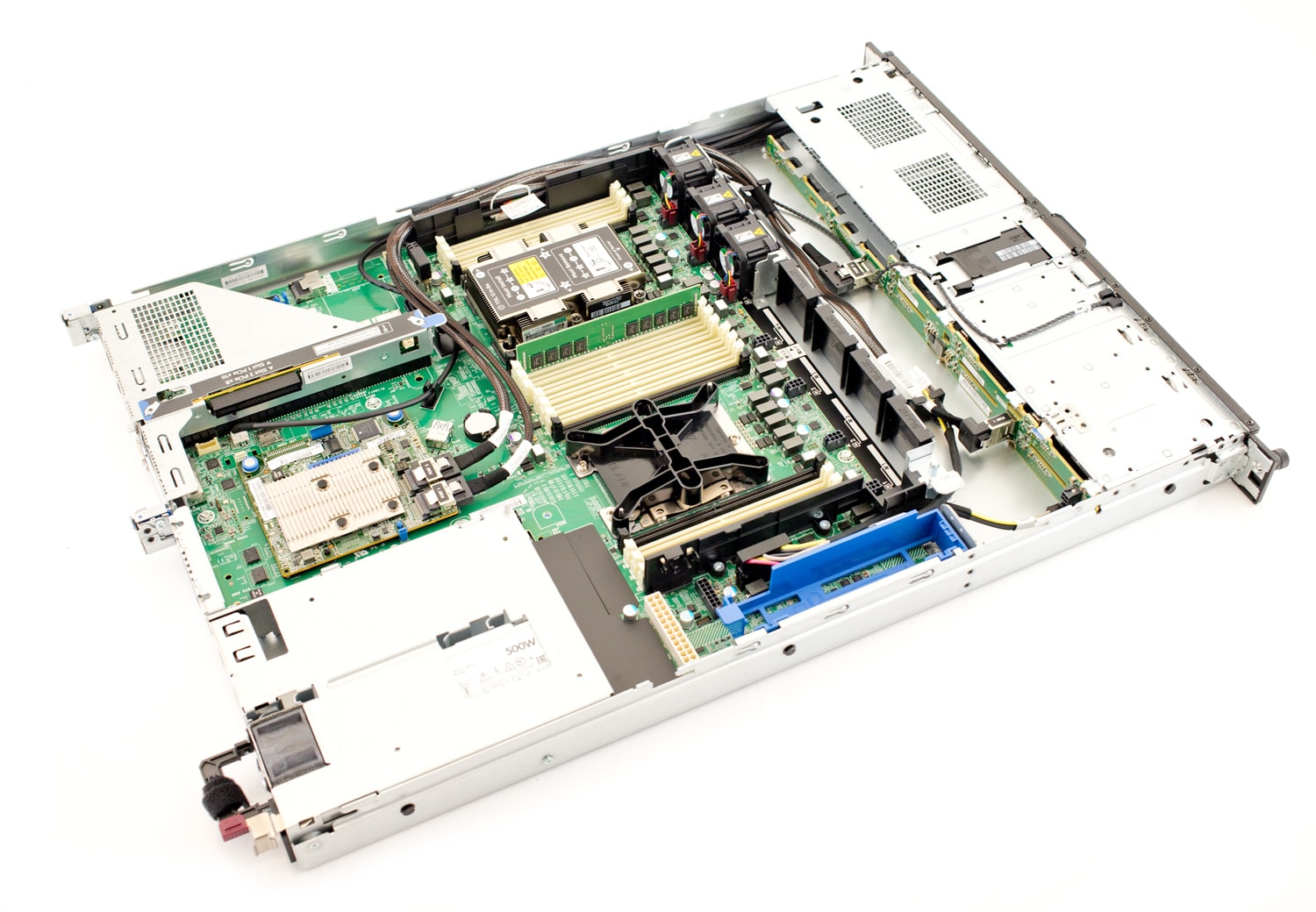
Looking at the front we see the backplane where all the drives are located. For our configuration, there are three fans; however, if we had gone with the dual-CPU configuration, all seven fan slots would be populated. The fans are small (which is normal for a 1U server due to the limited space available) and easily snap into the board for quick installation if you need to add more.
There are plenty of DIMM slots (a total of 12). The model sent to us by HPE only has one of them populated. Looking around further reveals a full RAID card at the back, which is very beneficial for managing the drives. Right next to it are the two PCIe slots, one 16x the other 8x.
It’s quite obvious that there isn’t a lot going on under the hood of the DL160; however, it comes with everything its target demographic needs at a price point around a $1,000. This is very reasonable for the hardware it provides. It also has ILO5, which is the big step up in the Gen10 models, so small businesses will get all of the manageability with ProLiant components.
HPE ProLiant DL160 Gen10 Management
The HPE ProLiant DL160 Gen10 leverages Integrated Lights-Out (iLO) 5 for management. We’ve done a fairly in depth look at iLO 5 that can be found here. Below are a few points on how it would look on the DL160.
Under the main Information tab there are several sub-tabs including Overview (viewed here), Security Dashboard, Session List, iLO Event Log, and Integrated Management Log. As the name implies, the Overview tab give general information about the system. It also gives users a quick glance at health and security of the system.
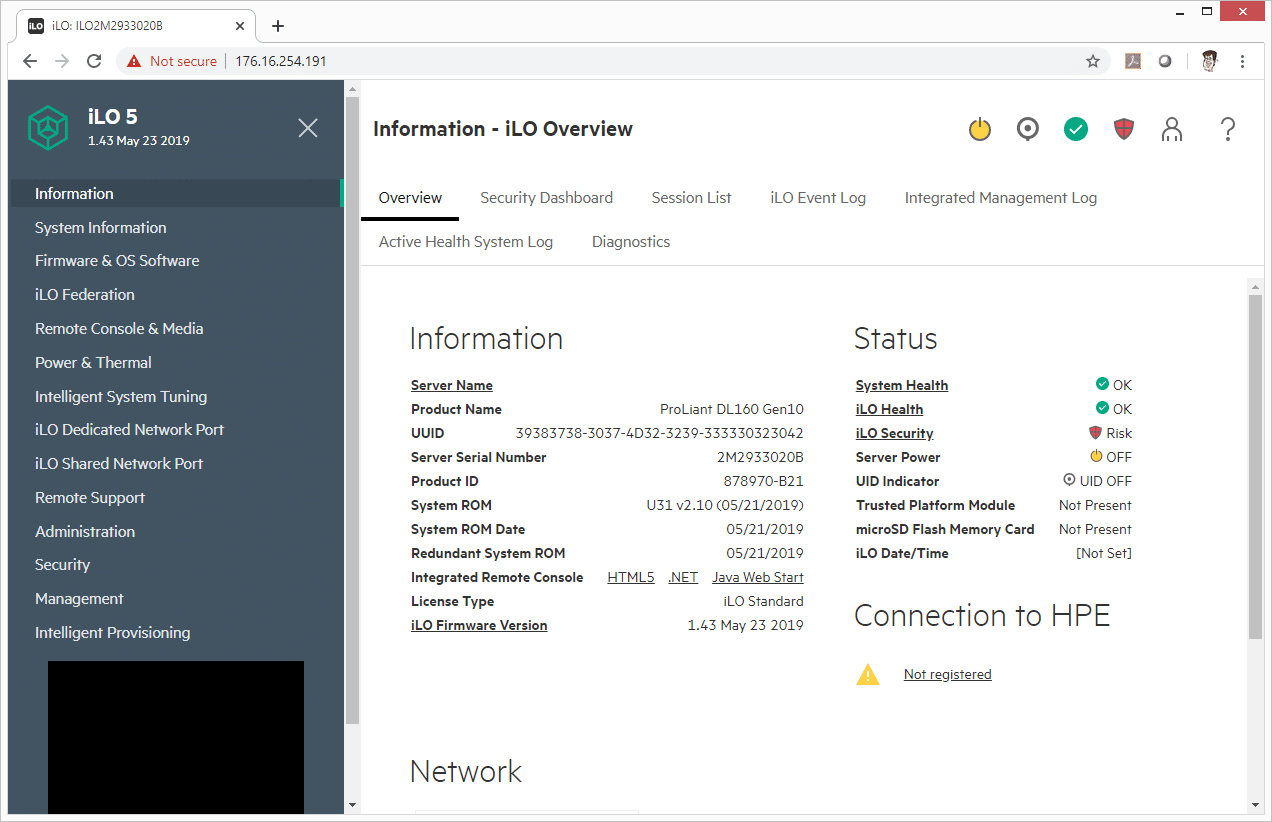
Under Power & Thermal there are various sub-tabs dealing with power usage including Sever Power, Power Meter, Power Settings, Power, Fans, and Temperatures. Here users can power on or off the server and check on various metrics of the system.
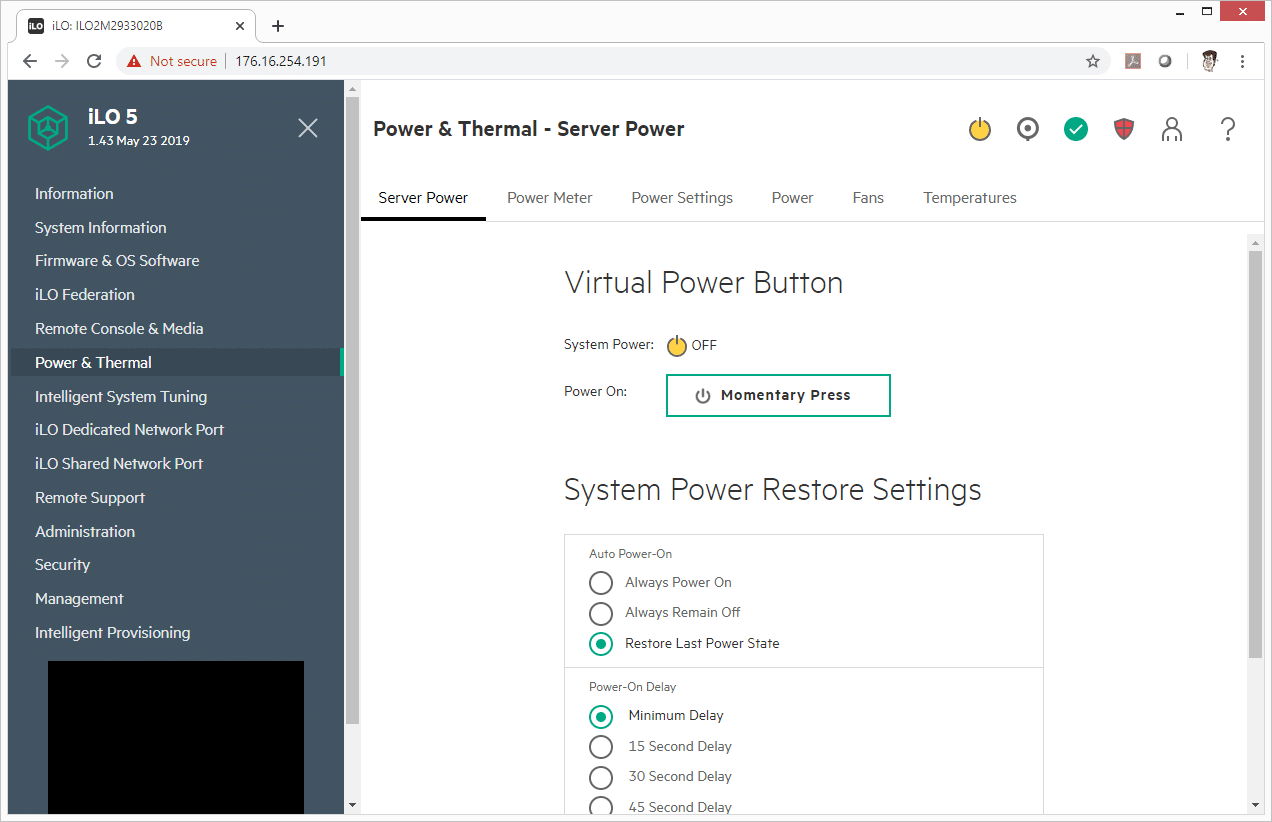
In these times remote support becomes even more important. Under the Remote Support tab, users can connect their device to HPE to help quickly troubleshoot issues.
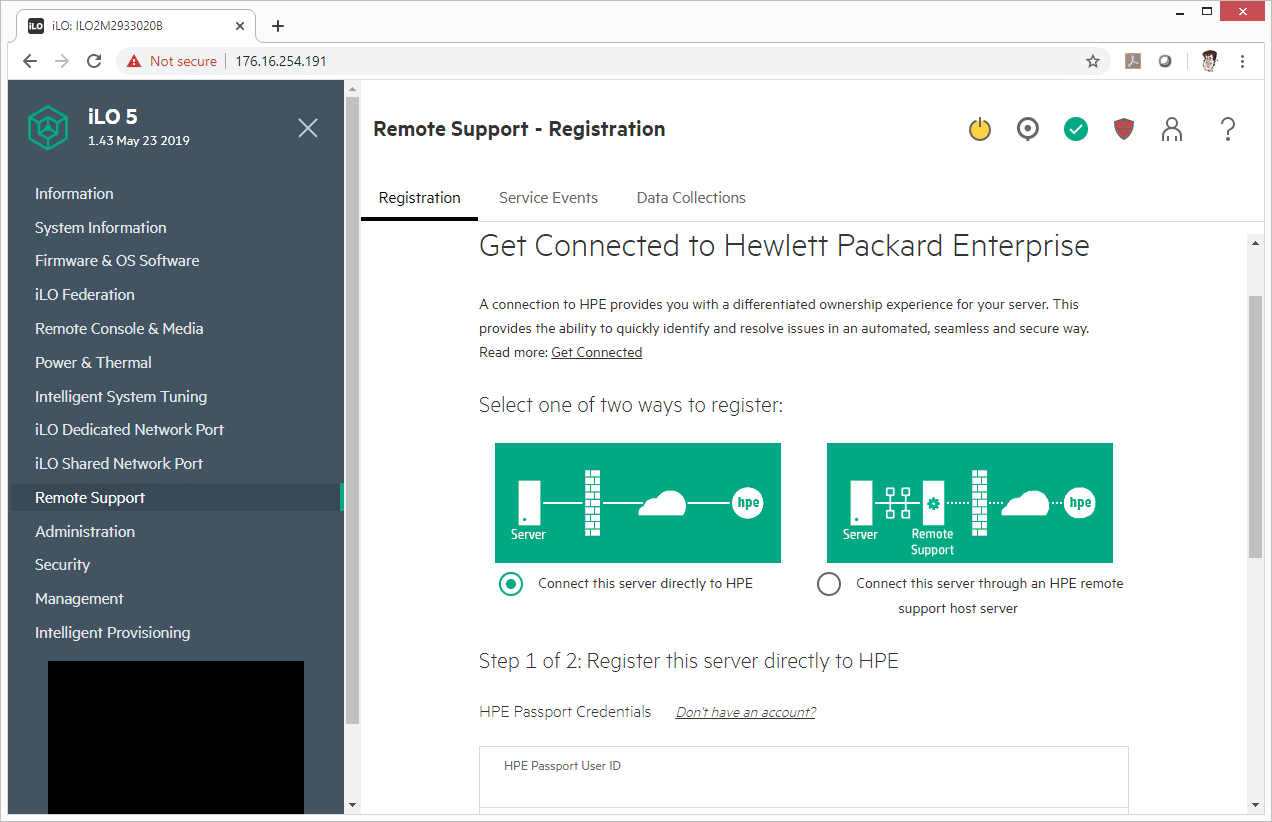
HPE ProLiant DL160 Gen10 Performance
For measuring the synthetic performance of the DL160 server, we outfitted the 2.5″ bays with eight Toshiba 400GB PX04SS SSDs which we tested in JBOD.
VDBench Workload Analysis
When it comes to benchmarking storage arrays, application testing is best, and synthetic testing comes in second place. While not a perfect representation of actual workloads, synthetic tests do help to baseline storage devices with a repeatability factor that makes it easy to do apples-to-apples comparison between competing solutions. These workloads offer a range of different testing profiles ranging from “four corners” tests, common database transfer size tests, as well as trace captures from different VDI environments. All of these tests leverage the common vdBench workload generator, with a scripting engine to automate and capture results over a large compute testing cluster. This allows us to repeat the same workloads across a wide range of storage devices, including flash arrays and individual storage devices.
Profiles:
- 4K Random Read: 100% Read, 128 threads, 0-120% iorate
- 4K Random Write: 100% Write, 64 threads, 0-120% iorate
- 64K Sequential Read: 100% Read, 16 threads, 0-120% iorate
- 64K Sequential Write: 100% Write, 8 threads, 0-120% iorate
- Synthetic Database: SQL and Oracle
- VDI Full Clone and Linked Clone Traces
With random 4K read, the HPE ProLiant DL160 Gen10 started at 22,615 IOPS at only 123.6µs latency and stayed under 1ms until about 200K IOPS while peaked at 210,150 IOPS at a latency of 3.1ms.
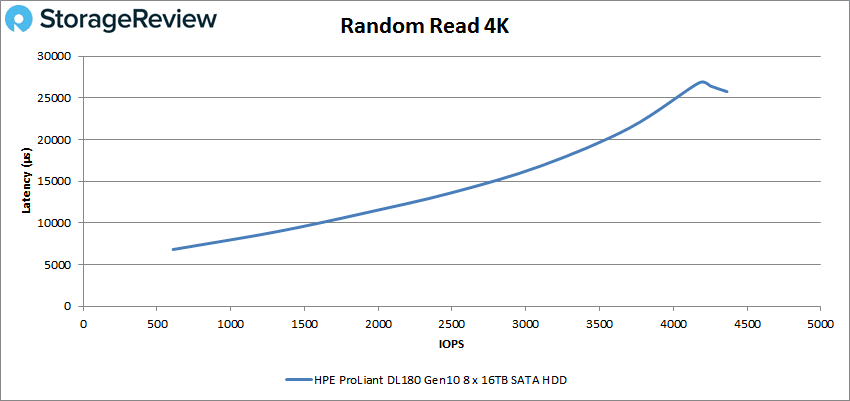 For random 4K write, the DL160 stayed under 1ms until about 176K IOPS while peaking at 182K with a latency of 3,541µs.
For random 4K write, the DL160 stayed under 1ms until about 176K IOPS while peaking at 182K with a latency of 3,541µs.
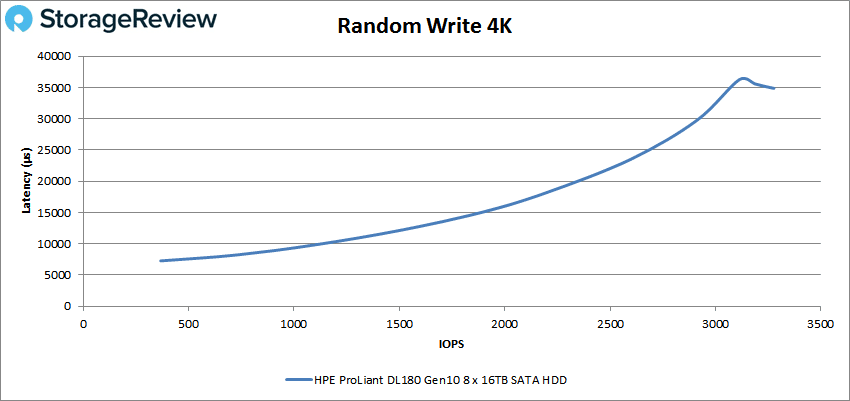 Switching over to sequential performance and starting with our 64K read, the DL160 continued its good latency results, showing sub-millisecond performance throughout a majority of the test (only breaking 1ms at just under 99K IOPS or 6.2GB/s. The HPE server peaked at about 105K IOPS or 6.2GB/s at 2.43ms.
Switching over to sequential performance and starting with our 64K read, the DL160 continued its good latency results, showing sub-millisecond performance throughout a majority of the test (only breaking 1ms at just under 99K IOPS or 6.2GB/s. The HPE server peaked at about 105K IOPS or 6.2GB/s at 2.43ms.
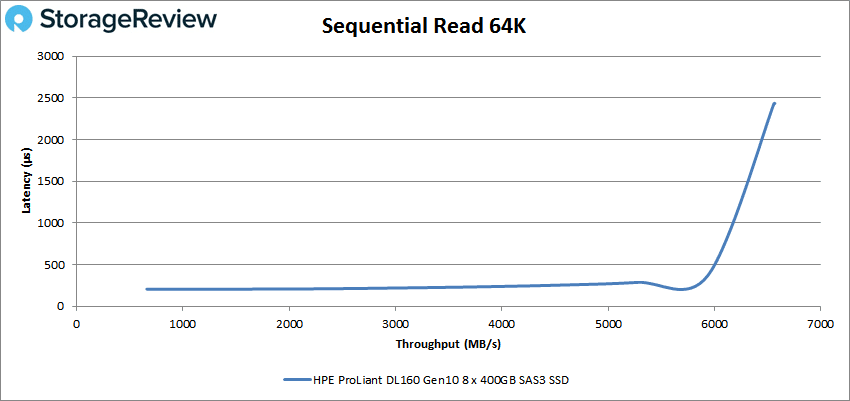
For 64K write, the DL160 showed sub-millisecond performance throughout the test until it hit 90K IOPS where it took a major spike in performance, ending at 1.4ms at 79K IOPS.
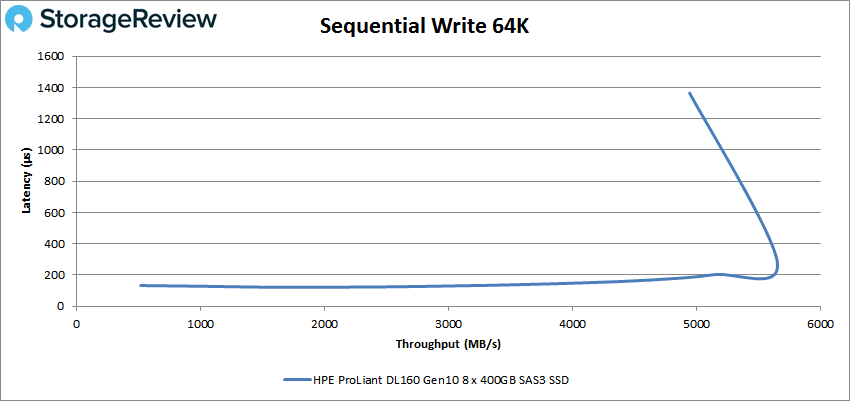
Our next set of tests are our SQL workloads: SQL, SQL 90-10, and SQL 80-20. Starting with SQL, the DL160 was able to perform at sub-millisecond latency up until the very end of the test, peaking at 250,077 IOPS at a latency of 1022µs.
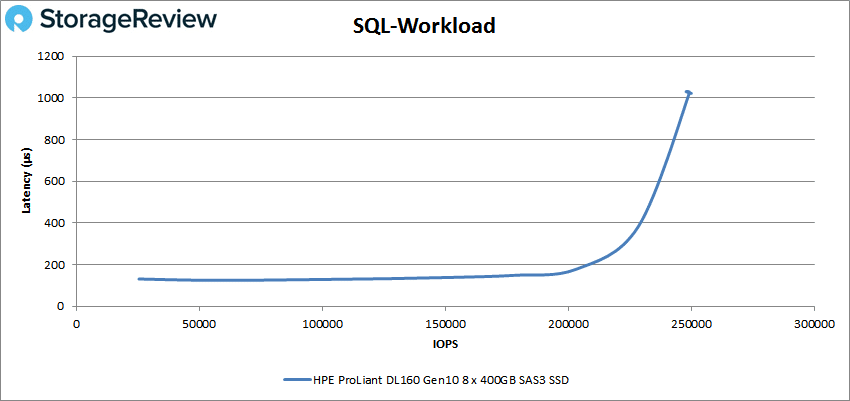
SQL 90-10 showed very similar performance, as it broke breaking 1ms at the very end with a peak of 245,120 IOPS at 1,042µs in latency.
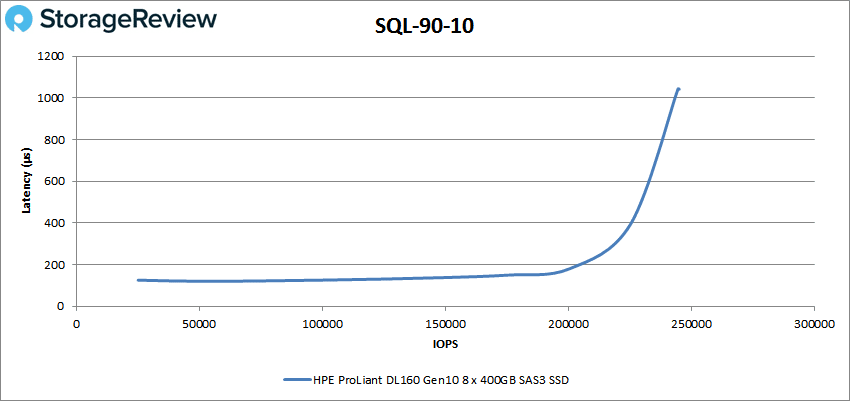
The DL160 finished our SQL tests with SQL 80-20, where the DL160 showed sub-millisecond latency until the very end again, peaking at 240,318 IOPS at a latency of 1,062µs.
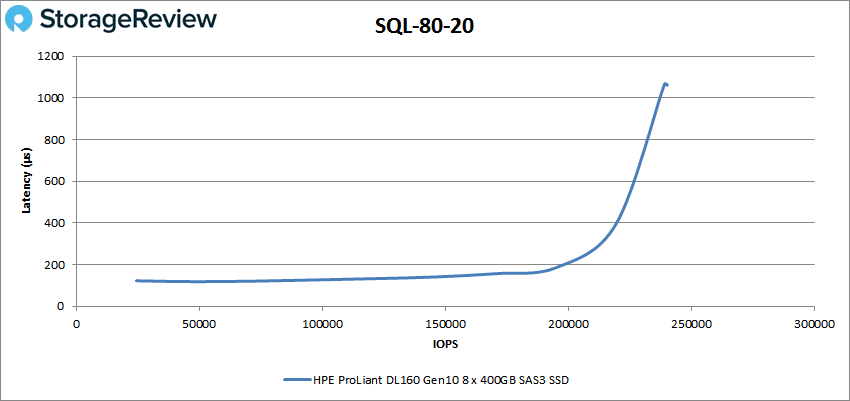
Next up are our Oracle workloads: Oracle, Oracle 90-10, and Oracle 80-20. Starting with Oracle, the DL160 showed sub-millisecond latency until roughly 225K IOPS, peaking at about 227K IOPS at 1,126µs latency.
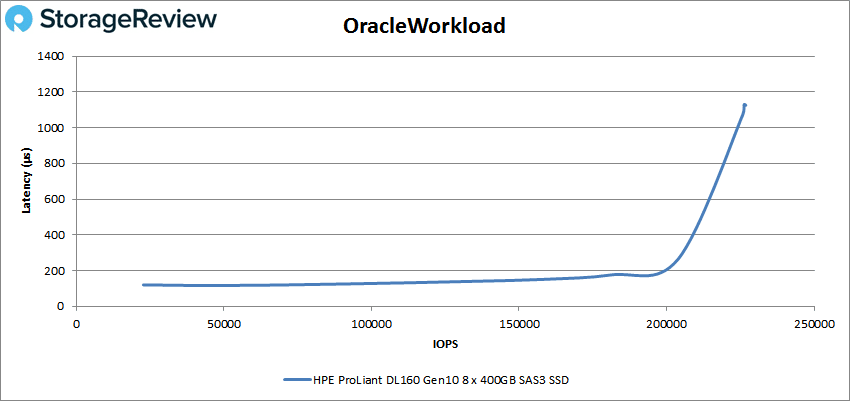
For Oracle 90-10, the DL160 showed sub-millisecond latency throughout the test, peaking at about 258K IOPS at 687µs latency.
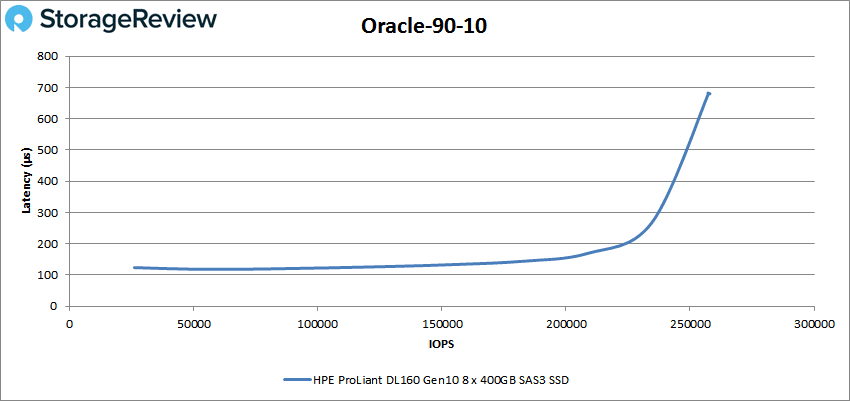
For Oracle 80-20, the DL160 continued its sub-millisecond latency showing, peaking at about 255K IOPS at 689µs latency.
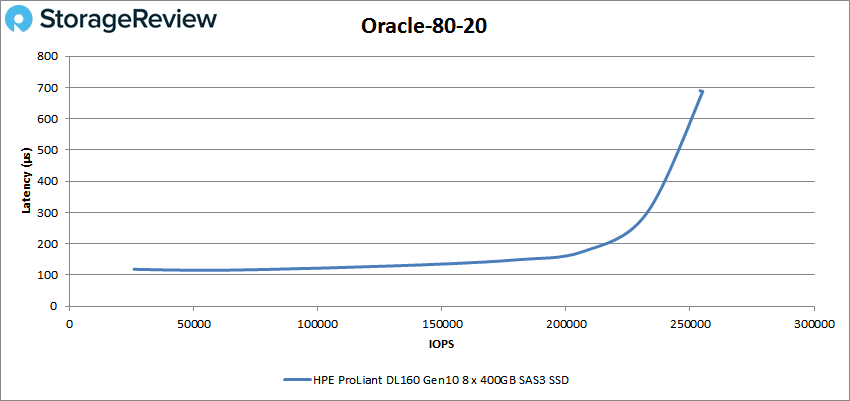
Next, we switched over to our VDI clone test, Full and Linked. For VDI Full Clone (FC) Boot, the HPE DL160 stayed under 1ms for most of the test and peaked at 174K IOPS at a latency of 1.44ms.
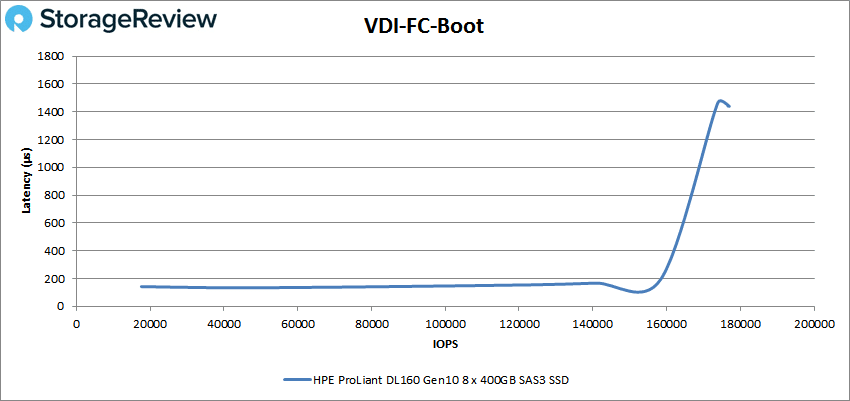
VDI FC Initial Login saw the DL160 with sub-millisecond latency performance until about 135K IOPS and a peak of about 139K IOPS at 1.62ms before dropping off a bit.
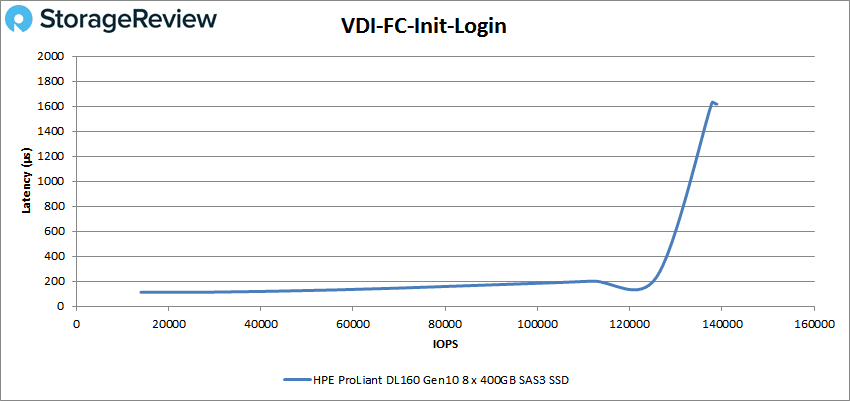
For VDI FC Monday Login the DL160 had sub-millisecond latency throughout the entire test while peaking at 173K IOPS with a latency of 5.74ms before dropping off a bit again.
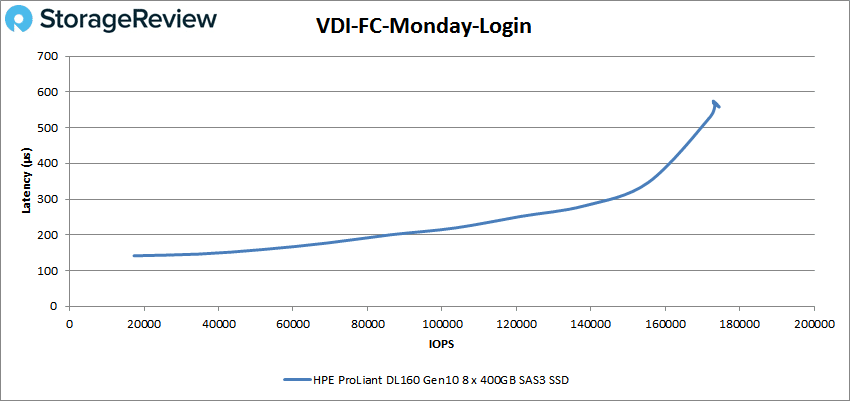
For VDI Linked Clone (LC) Boot, the DL160 had sub-millisecond latency performance throughput with a peak of 191,625 IOPS and a latency of 550.4µs.
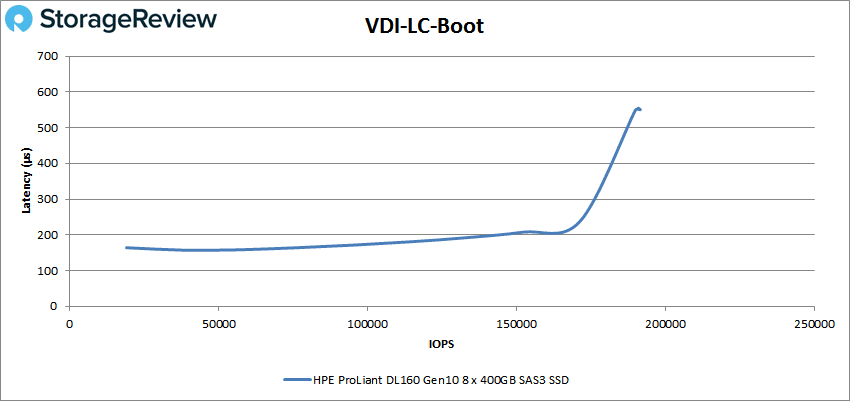
VDI LC Initial Login saw performance well under a millisecond throughout, peaking at 130,798 IOPS with a latency of 346µs.
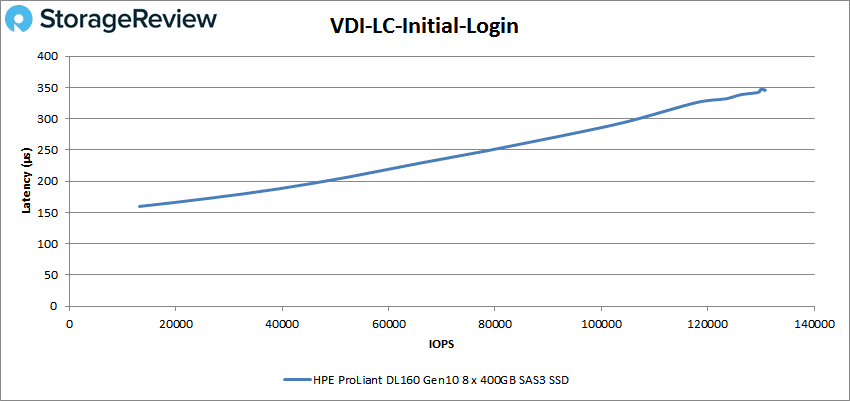
Lastly, our VDI LC Monday Login showed the DL160 with sub-1ms performance again, peaking at 131,571 IOPS at a latency of 704µs before.
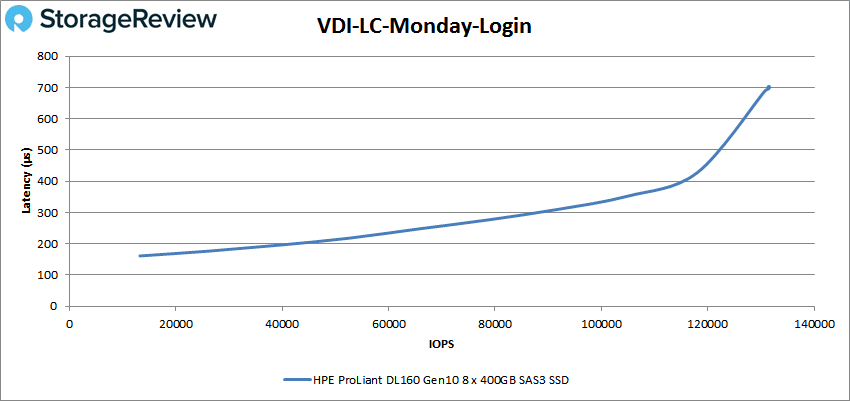
Conclusion
The HPE ProLiant DL160 Gen10 is a dual-socket 1U server designed for SMBs that have a very limited IT budget. Though it is priced around just 800 to 900 for a barebones model, users can outfit it with dual CPUs (a range of Xeon processors) with a generous amount of RAM (maximum build at 16 x 64 GB LRDIMM @ 2933 MT/s). It also has several storage configurations and can be populated with upwards of 77TB in capacity when using 7.68TB drives in the 8-bay server and the two expansion slots. The DL160 is another entry in HPE’s budget friendly ProLiant line, like the PE ProLiant DL180 Gen10.
To test its performance goes, we put the entry-level Gen10 server through our VDBench workloads. Here, the DL160 showed peaks of 210K IOPS in 4K read, 182K in 4K write, 6.2GB/s in 64K read, and 5.6GB/s in 64K write. For our SQL workloads, the server hit 250K IOPS, 245K IOPS in SQL 90-10, and 240K IOPS in SQL 80-20. Oracle saw the DL160 reach peaks of 227K IOPS, 258K IOPS in Oracle 90-10, and 255K IOPS in Oracle 80-20. In our VDI clone test we saw peak numbers of 174K IOPS for FC Boot, 139K IOPS for FC Initial Login, 173K IOPS for FC Monday Login, 192K IOPS for LC Boot, 131K IOPS for LC Initial Login, and 132K IOPS for LC Monday Login.
Overall, the DL160 performed as expected for an entry-level server. Though it certainly caters to those who don’t need all the configuration and features of high-end models, the DL160 is an excellent choice for small businesses with a tight budget that still want a high-quality offering from HPE.
Engage with StorageReview
Newsletter | YouTube | Podcast iTunes/Spotify | Instagram | Twitter | Facebook | RSS Feed

